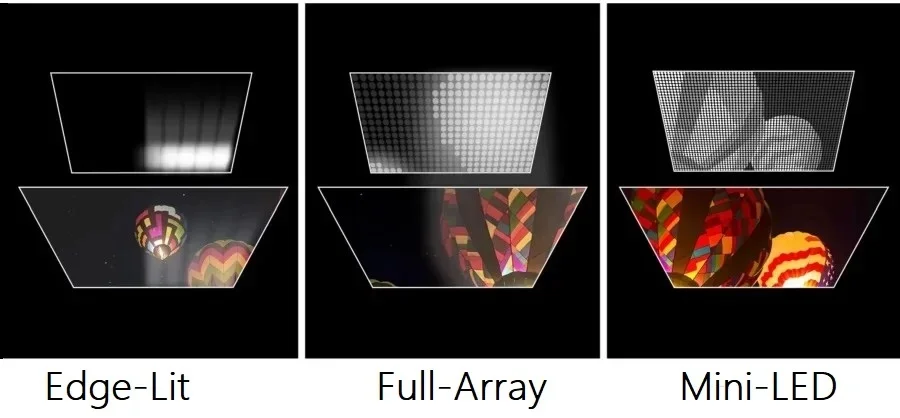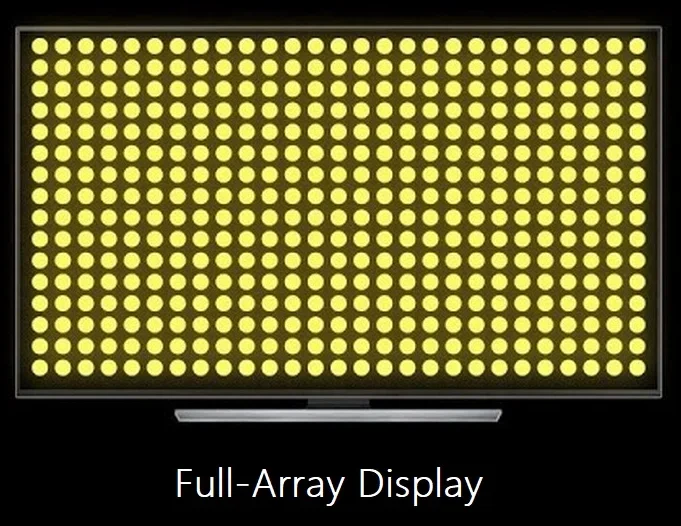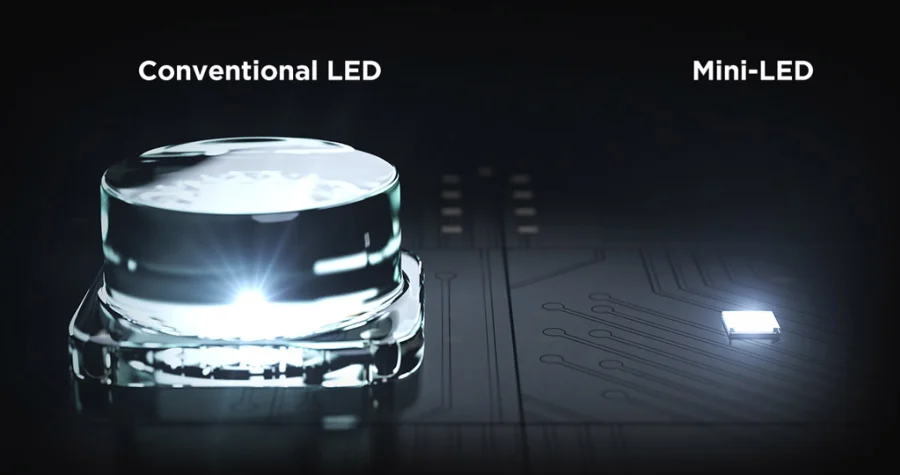
Local dimming is a display technology that enables a screen to adjust the brightness of specific areas independently, rather than applying a uniform brightness across the entire panel.
This capability significantly enhances display quality by improving contrast and delivering deeper black levels, both of which are essential for a rich, immersive viewing experience.
Whether you’re watching a movie with dark, moody scenes or enjoying vibrant HDR content, local dimming plays a pivotal role in making images pop.
What is Local Dimming?
At its core, local dimming is a backlight control technology used in Liquid Crystal Displays (LCDs). LCD panels themselves don’t produce light; they act like shutters, blocking or allowing light from a separate backlight (typically LEDs) to pass through to create an image.
Local dimming technology allows different segments, or zones, of this backlight to be independently brightened or dimmed based on the content displayed in that specific area of the screen.
The primary purpose of local dimming is to significantly enhance the contrast ratio – the difference between the brightest white and the deepest black a display can produce simultaneously.
By dimming the backlight behind dark portions of an image, local dimming allows LCDs to achieve much darker black levels than they could otherwise.
Conversely, keeping the backlight bright behind luminous parts of the image maintains highlights. This results in a more dynamic and visually impactful picture.
This contrasts sharply with global dimming, a simpler technique where the entire backlight adjusts its brightness based on the overall average brightness of the scene.
While global dimming can help slightly, it cannot simultaneously display bright highlights and deep blacks effectively, often crushing detail in shadows or washing out dark scenes. Local dimming provides a more granular, spatially aware approach.
Types of Local Dimming
Local dimming isn’t a monolithic technology; its implementation significantly impacts performance. The main types are:
Edge-Lit Local Dimming
LEDs are positioned along one or more edges of the display panel (typically top/bottom or sides). Light guide plates(LGP) are used to diffuse this light evenly across the back of the LCD.

Dimming is achieved by controlling segments of these edge LEDs. The number of controllable zones is typically limited, often numbering in the tens.
Pros: Allows for thinner and potentially less expensive display designs.
Cons: Offers the least precise control. Light modulation occurs in relatively large, often vertical or horizontal bands, making it difficult to dim small dark areas next to large bright ones without compromise. This can lead to noticeable light bleed or uniformity issues.
Full-Array Local Dimming (FALD)
LEDs are arranged in a grid directly behind the entire surface of the LCD panel. This grid is divided into numerous zones (ranging from dozens to hundreds, or even low thousands in high-end models) that can be controlled independently.

When displaying an image, the TV’s processor analyzes the content and adjusts each zone’s brightness in real time. For instance, if a scene shows stars in a night sky, only the LEDs behind the stars stay at full brightness, while those behind the dark sky dim completely.
Pros: Provides significantly better control over light levels across the screen compared to edge-lit systems. Enables deeper blacks, higher contrast, and better HDR performance due to more precise light management.
Cons: Results in thicker display panels compared to edge-lit designs. Generally more expensive to manufacture. Can still suffer from blooming artifacts, though typically less severe than edge-lit, depending heavily on the zone count and control algorithm.
Mini-LED Local Dimming
This is an evolution of FALD that utilizes much smaller LEDs (typically defined as having a die size under 0.2mm or 200 micrometers). Because the LEDs are dramatically smaller, vastly more of them can be packed behind the panel.

This allows for a significant increase in the number of independently controllable dimming zones, often numbering in the thousands or even tens of thousands.
For example, when displaying a movie with subtitles, only the LEDs directly behind the text stay lit, while the rest of the screen remains dark—minimizing blooming.
Pros: Offers substantially improved precision over traditional FALD, leading to better contrast, near-OLED black levels, and higher peak brightness capabilities. Blooming is often significantly reduced due to the finer granularity of control.
Cons: Currently the most expensive form of LED-based local dimming. Still an LCD technology, so perfect per-pixel control like OLED is not possible, and some minor blooming may still be visible in challenging scenes. Requires sophisticated processing to manage the vast number of zones effectively.
Comparison
| Feature | Edge-Lit Local Dimming | Full-Array Local Dimming (FALD) | Mini-LED Local Dimming |
|---|---|---|---|
| LED Placement | LEDs along edges (sides/top/bottom) | Grid of LEDs behind the panel | Thousands of tiny LEDs (<0.2mm) densely packed |
| Dimming Zones | 10–32 zones | Dozens to hundreds | Hundreds to thousands |
| Black Levels | Mediocre (light bleed/blooming) | Very good (deep blacks) | Near-OLED (minimal blooming) |
| Peak Brightness | Moderate (~600 nits) | High (~1,000–1,500 nits) | Very high (1,500–2,000+ nits) |
| HDR Performance | Limited | Excellent | Outstanding |
| Screen Thickness | Ultra-thin | Thicker | Moderate (thicker than edge-lit) |
| Cost | Budget-friendly | Premium | High-end (most expensive) |
| Best For | Casual viewers, budget TVs | Enthusiasts, high-end LCD TVs | High-end HDR, professional monitors |
Benefits
Effective local dimming brings tangible improvements to image quality:
Improved Contrast
This is the primary benefit. By allowing parts of the screen to be significantly darker than others, the perceived dynamic range increases dramatically compared to LCDs without local dimming, whose native contrast ratios typically range from around 1000:1 (IPS panels) to 5000:1 (VA panels).
Better Black Levels
Dimming the backlight in dark areas leads to deeper, more convincing blacks, reducing the grayish appearance often seen on non-dimming LCDs, especially in dark viewing environments.
High-end displays like Apple Pro Display XDR achieve 0.04-nit black levels.
Enhanced HDR Performance
High Dynamic Range (HDR) content relies on displaying a wider range of luminance, from very deep blacks to very bright highlights.
Local dimming is essential for LCDs to effectively render HDR, allowing them to achieve the high peak brightness in specific areas (e.g., explosions) while maintaining dark shadows elsewhere, crucial for meeting HDR standards like HDR10 or Dolby Vision.
Downsides
Despite its benefits, local dimming isn’t perfect and can introduce artifacts:
Blooming (Halo Effect)
This is the most common artifact. It occurs when light from a bright zone spills over into adjacent darker zones, creating a visible halo or glow around bright objects on a dark background (e.g., white text on a black screen, stars in space).
The severity depends on the number and size of the zones – fewer, larger zones (especially edge-lit) exhibit more blooming than numerous small zones (Mini-LED).
Dimming Zone Limitations
Even with FALD or Mini-LED, a single dimming zone may contain both very bright and very dark image elements.
The display’s algorithm must then choose a compromise brightness level for that zone, potentially clipping bright details or lifting black levels within that zone.
A starfield demonstration reveals this limitation clearly – while OLED renders individual pinpoint stars perfectly, FALD displays show small clusters of stars lighting up entire dimming zones.
Variability in Quality
The effectiveness of local dimming varies enormously between different display models, even those using the same type (e.g., FALD).
Factors include the number of zones, the peak brightness of the LEDs, the speed of the zone transitions, and, crucially, the sophistication of the control algorithm managing the zones.
A poorly implemented algorithm can cause distracting brightness fluctuations or visible zone transitions.
Local Dimming vs. Other Contrast Enhancement Technologies
Local Dimming vs. Dynamic Contrast
“Dynamic Contrast Ratio” is often a marketing specification achieved through simpler means, sometimes just global dimming or image processing that adjusts the overall brightness or gamma curve based on scene content.
When detecting a dark scene, the system dims the whole backlight uniformly; for bright scenes, it boosts backlight power. While this can create the appearance of deeper blacks in some content, it comes with significant drawbacks.
It doesn’t offer the spatial control of local dimming and often leads to crushed blacks or blown-out highlights. The extremely high numbers quoted (e.g., millions-to-one) are typically not representative of simultaneous contrast performance.
Local Dimming vs. Self-Emissive Pixels
Local dimming is an attempt by LCD technology to approximate the per-pixel light control that is inherent to self-emissive technologies like OLED or Micro-LED.
While advanced Mini-LED systems get remarkably close, self-emissive technologies’ ability to switch off individual pixels remains the gold standard for black-level purity and eliminates blooming artifacts entirely.
OLED on the other hand has lower peak brightness than high-end LCDs with FALD/Mini-LED, potential burn-in risk with static content, and higher production costs at larger screen sizes.
Future of Local Dimming Technology
Advancements in Mini-LED and Micro-LED
Mini-LED technology is rapidly maturing, with manufacturers increasing zone counts and refining algorithms. They also have better thermal efficiency than standard LEDs.
The next major step is Micro-LED. Micro-LED uses microscopic, self-emissive inorganic LEDs for each pixel.
This technology wouldn’t require “local dimming” in the traditional sense, as it offers per-pixel control, potentially combining OLED’s contrast benefits with higher brightness, longer lifespan and no risk of burn-in associated with organic compounds.
However, Micro-LED currently faces significant manufacturing cost and scalability challenges.
AI-Driven Local Dimming Improvements
Sophisticated algorithms, increasingly leveraging artificial intelligence and machine learning, are being developed to manage local dimming zones more effectively.
These algorithms can analyze image content in real-time, predict motion, and make smarter decisions about zone brightness to minimize artifacts like blooming, improve response times, and optimize power consumption, further refining the performance of FALD and Mini-LED displays.
One example of this would be Samsung’s The Frame Pro, powered by the NQ4 Gen3 AI Processor, which utilizes advanced AI-driven processing to enhance local dimming precision. By intelligently adjusting brightness levels based on scene analysis, it reduces halo effects, improves contrast, and delivers deeper blacks with greater overall image clarity.
Conclusion
Local dimming is a vital technology for pushing the image quality of LCD displays. While not without its imperfections, particularly in less sophisticated implementations, it delivers substantial improvements in contrast and HDR performance.
As Mini-LED evolves and manufacturers refine their control algorithms, local dimming will continue to play a critical role in the premium display market, striving to close the gap with self-emissive technologies like OLED and the upcoming Micro-LED.
Local dimming will remain a critical component of high-end display technology for the foreseeable future, particularly in large-screen applications where LCD maintains cost advantages.
As Micro-LED development progresses, the display landscape may eventually shift, but for now and likely through the next decade, local dimming continues to represent the most practical path to achieving reference-quality contrast in mainstream displays.
Q&A
Is local dimming needed for HDR?
While not strictly required to process HDR, effective local dimming is crucial for LCD/LED TVs to display HDR well. It significantly boosts contrast by allowing deeper blacks next to bright highlights, which is essential for the impactful look of HDR. Without it, HDR content on an LCD can appear washed out and lack depth. OLED TVs achieve this contrast differently and don’t need local dimming.
Should I have local dimming on or off?
For the best picture quality, especially with movies and HDR, you should generally leave local dimming ON. It’s designed to enhance contrast and black levels. However, if you notice distracting visual artifacts like blooming, try lowering the setting (e.g., from High to Medium or Low). Turn it completely OFF only if these side effects are too bothersome for your viewing.
What are the disadvantages of local dimming?
The main drawbacks stem from the backlight zones being larger than individual pixels. This can cause “blooming” or halos around bright objects on dark backgrounds. Sometimes, aggressive dimming can crush details in shadows, or you might notice distracting shifts in brightness as zones turn on and off. The severity of these issues varies greatly depending on the TV’s quality and number of dimming zones.
Should I get a TV with local dimming?
If you’re buying an LCD/LED TV and care about good contrast, deep black levels, and strong HDR performance, then yes, getting a model with local dimming is highly recommended. Look for Full Array Local Dimming (FALD) implementations for the best results, as they offer more precise control than edge-lit systems. It’s a key feature for maximizing picture quality on non-OLED TVs.
Is local dimming better than direct lit?
Local dimming generally offers superior picture quality compared to basic “direct lit” TVs without dimming zones. While both place LEDs directly behind the screen (unlike edge-lit), standard direct-lit TVs illuminate the whole screen uniformly. Local dimming adds controllable zones to this direct backlighting, allowing for much better contrast and black levels. Therefore, direct-lit with local dimming is better than direct-lit without it.
Does OLED need local dimming?
No, OLED TVs do not need local dimming. OLED technology is fundamentally different; each individual pixel generates its own light and can be turned completely off independently. This means OLEDs can achieve perfect black levels and infinite contrast at the pixel level naturally, without requiring a separate backlight or dimming zones. Local dimming is a technology designed to improve contrast on backlit LCD-based TVs.
Read Next













